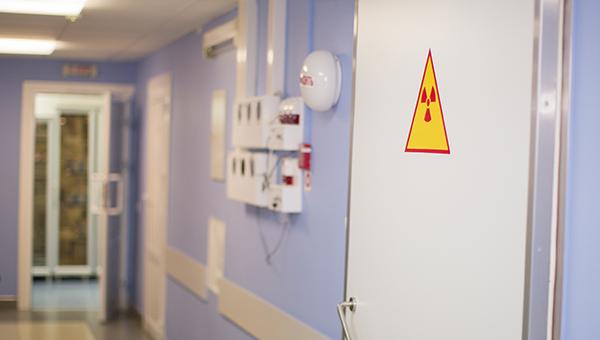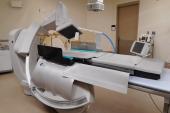PCI Radiation Dose in Germany Has Nose-dived, but Gains Are Patchy
A decade of data show there’s still room for improvement: frequent assessment of protocols and benchmarking would help.

Despite the increasing complexity of procedures, radiation dosing during PCI has decreased by 36% over the last decade, according to data from the German PROTECTION VIII study.
“Importantly, a large variability in median radiation dose was observed between catheterization laboratories, which suggests the need for further site-specific training and education as well as the standardized implementation of advances technology and low-dose procedural protocols,” write the authors, led by Thomas J. Stocker, MD (Ludwig-Maximilians-University, Munich, Germany).
In an email to TCTMD, Stocker noted that PROTECTION VIII is the largest radiation-dose survey of PCI practice and provides useful benchmarks for interventional cardiologists.
“Institutions should constantly register their radiation-dose exposure of all performed cardiac catheterization procedures. This information should be used for improving radiation dose-reduction strategies that are of particular importance in high-dose PCI scenarios,” Stocker said.
The study enrolled 3,704,986 patients with a median age of 70 years who underwent a variety of PCI procedures between 2008 and 2018.
“I agree with the authors wholeheartedly that the hospital-level variability is an opportunity and a target for quality improvement,” said Ryan D. Madder, MD (Spectrum Health, Grand Rapids, MI), commenting on the findings for TCTMD. While it’s encouraging that dose has declined over time despite the increasingly complex case mix, he added, it’s unclear whether similar reductions have occurred in the United States, given the greater proportion of obese PCI patients. In a 2019 study, Madder’s group found that a body mass index (BMI) of 40 kg/m2 or higher was associated with roughly a doubling of patient radiation dose and an increase in both physician and patient exposures compared with a BMI of less than 25 kg/m2.
Stocker said he agreed that generalizability of the results to other countries “might be limited,” and added that patient weight and BMI were not available in the quality-assurance registry and could not be analyzed.
The PROTECTION VIII findings were published online January 24, 2022, in EuroIntervention.
PCI Volume Not a Factor
Stocker and colleagues analyzed data from a nationwide quality assurance program that provided information initially on PCI-related radiation dosing from 611 cath labs at the start of the study in 2008, with a total of 860 cath labs reporting by 2018. The most common indication for PCI was stable angina in 37.5% of patients, followed by unstable angina and NSTEMI in 33.2%, and STEMI in 18.5%.
The median dose area product (DAP) was 4,203 cGy/ cm2 at the start of the study, which decreased by 36% to 3,070 cGy/ cm2 in 2018 (P < 0.001). Median effective dose decreased 27% over the same period, from 9.2 mSv to 6.7 mSv (P < 0.001).
In this day and age, a patient really should get the same radiation dose regardless of which hospital they have their PCI performed in, but that's unfortunately still just not the case. Ryan D. Madder
A variability in median DAP of 5.3-fold was observed among 747 cath labs that performed at least 25 PCI procedures in 2017 and 2018. The lowest median DAP among these was 1,137 cGy/cm2 and the highest was 5,997 cGy/cm2. When these centers were stratified by their volume in 2017 and 2018, high-volume sites (> 1,103 PCIs) had higher median DAP at 3,458 cGy/cm2 than the moderate- or low-volume sites. However, both high- and low-volume sites had similarly high rates of hospital-level variability in radiation dosing (P < 0.001 for all comparisons).
To TCTMD, Stocker said that finding was surprising “because one might have thought that high-volume sites would be more focused on radiation dose reduction in cardiac catheterization.”
The study also found that compared with female gender, male gender was associated with a 38% increased DAP, while PCI in patients with a history of CABG was associated with a 32% increase compared with patients with native coronary arteries. Higher NYHA class also was a predictor of higher DAP, increasing by 2% in those with class I, 9% in those with class II, 22% in those with class III, and 34% in those with class IV in comparison to patients without symptoms of HF (P < 0.001 for all comparisons).
Characteristics of the lesions undergoing PCI also served as predictors of greater DAP use. Compared with a nonoccluded artery, an occluded coronary artery was associated with a 25% increase in DAP, and an ostial versus nonostial lesion with a 27% increase. Left main and multivessel PCI also were associated with increased radiation dose exposure. Multivariate regression analysis confirmed all these characteristics as independent and clinically significant predictors of greater radiation dose exposure in PCI.
The Importance of Benchmarking
In the paper, Stocker and colleagues recommend that institutions participate in radiation-dose surveys, allowing benchmarking with other physicians and institutions.
“The participation in such programs might improve ‘best practice’ performance. Furthermore, the certification of catheterization laboratories which adhere to ‘best practice’ recommendations will help patients and doctors to select centers with low radiation exposure for cardiac catheterization,” they write.
“In this day and age, a patient really should get the same radiation dose regardless of which hospital they have their PCI performed in, but that's unfortunately still just not the case,” Madder added. “The fact that hospital-level variability drives radiation dosing more than almost anything else just demonstrates that we have to do a better job in cath labs to try to get a more-uniform low dose across the board.”
Madder noted that while resolving the variability problems at individual centers is difficult, they exist for several reasons.
“It's a combination of different hospitals having different radiation-safety cultures, and probably not focusing on [the issue] enough,” he said. “I think it also has to do with the equipment that is in cath labs. Newer fluoroscopy systems that have come out in the last several years really seem to emit much lower doses of radiation than some of the more outdated equipment. One would expect that in hospitals that are still using some of the more outdated equipment, patients are having higher radiation doses. I think it's an area for opportunity to try to get more state-of-the-art equipment.”
While some institutions may balk at the cost of upgrading older equipment, Madder believes a “safety-first” mindset regarding radiation exposure to both patients and staff needs to be top of mind, something he said that more and more institutions seem to understand.
“The one thing that I think is clear from this study and prior ones is that all cath labs everywhere can do a better job when it comes to radiation safety. Even for institutions where this is a focus and they've worked on it, there's still room for improvement,” he added.
L.A. McKeown is a Senior Medical Journalist for TCTMD, the Section Editor of CV Team Forum, and Senior Medical…
Read Full BioSources
Stocker TJ, Abdel-Wahab M, Möllmann H, et al. Trends and predictors of radiation exposure in percutaneous coronary intervention: the PROTECTION VIII study. EuroIntervention. 2022;Epub ahead of print.
Disclosures
- Stocker reports no relevant conflicts of interest.
- Madder reports research support, speaker honoraria, and serving on the advisory board of Corindus, A Siemens Healthineers Company.





Comments